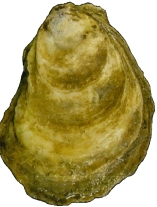I’ve mentioned oysters before in these pages (I should probably give posts about them a separate category by now), but while scooping a few dozen of them out of Wellfleet Harbor this weekend, I noticed something about them that I hadn’t realized before, which is that they seem to exhibit a consistent chirality.
The term “chirality” refers to the “handedness” of an object. The two gloves that make a pair have opposite chirality. Objects that are mirror images in this 3-D way, but are identical otherwise — like gloves, for example (or the hands that wear them) — are called enantiomorphs.
There are all sorts of things in nature that come in enantiomorphic variants. Many crystalline minerals, for example calcite, are found equally in left- and right-handed versions, and at smaller scales there are a great number of molecules that can be put together either way (in fact the chirality of crystals is often simply the chirality of its component molecules writ large). When two molecules of the same compound are found in enantiomorphic variants, they are known as stereoisomers. In contrast to ordinary isomers, in which the same group of atoms are linked together at different points in the molecular structure, stereoisomers have exactly the same structure, only turned the other way. Their chemical properties are identical, except when they must interact with other stereoisomers — because the physical conformation of the molecules affects what bonding sites are exposed to each other — and that’s when things get interesting.
When molecules appear in the nonliving world, they appear in equal numbers of left- and right-handed (dextral and sinistral) versions. No environmental influences — gravity, light, etc. — have any preferred left-right direction, so both forms occur in equal abundance. This is called a racemic mixture. There is one big exception, though, which is the molecules found in living organisms. Whenever molecules that in abiotic nature can occur in two differently handed forms are found in living things, they always take just one enantiomorphic form, and it is almost always the same form for the same molecule across all species. The reason, presumably, is that once an arbitrary choice of handedness was made for a particular molecule by our ancestors, the unbroken chain of molecular synthesis that has proceeded ever since made only copies that turned the same way. The original choice could have gone either way, but once the decision was made, we stuck to it. This sort of thing occurs often in the natural world, and is known as “spontaneous symmetry breaking”.
When organic molecules have been synthesized with opposite handedness, the effects on living things are unpredictable. Some drugs are greatly more or less effective than their enantiomorphic opposites, and it has been discovered that there are substances that smell differently depending on their handedness. In fact, it turns out that the difference between the smell of oranges and lemons is due to the fact that they contain different stereoisomers of the compound limonene.
And so we come to oysters. If you look at the oyster below (shown supine), you will see that it shows a distinct asymmetry, convex on the right and concave on the left:

I’d always been aware that oysters were asymmetrical, of course — they are as unique as snowflakes, and gnarled into a diverse assortment of shapes — but what I hadn’t realized until this weekend was that all the oysters I find in Wellfleet Harbor seem to curve in the same direction. I know that many molluscs exhibit this sort of handedness; snails may spiral in directions that vary by species, or by region — but I haven’t yet found out how it is with oysters (perhaps because I just started thinking about it a few days ago, and haven’t really made the slightest effort). I also know the Wellfleet oysters passed though a population bottleneck many years back; perhaps there was a “racemic” mixture prior to that event. Perhaps other local populations of crassotrea virginica do indeed contain instances of both, or maybe they vary by region, or it might be that their handedness is a way to tell different oyster species apart. It should make sense, of course, to readers who have seen some of my other posts about Wellfleet, that around here even the oysters skew to the left.
Obviously I need to do some more research. Meanwhile, if you’d like to learn more about the fascinating topic of chirality in physics and biology, you could do no better than to get hold of The Ambidextrous Universe, an outstanding book by the brilliant polymath Martin Gardner.